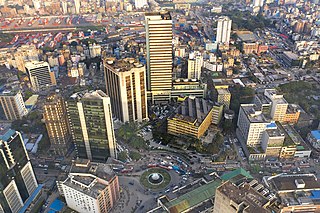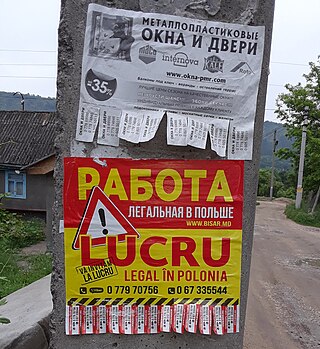Related Research Articles

Bangladesh is a densely populated, low-lying, mainly riverine country located in South Asia with a coastline of 580 km (360 mi) on the northern littoral of the Bay of Bengal. The delta plain of the Ganges (Padma), Brahmaputra (Jamuna), and Meghna Rivers and their tributaries occupy 79 percent of the country. Four uplifted blocks occupy 9 percent and steep hill ranges up to approximately 1,000 metres (3,300 ft) high occupy 12 percent in the southeast and in the northeast. Straddling the Tropic of Cancer, Bangladesh has a tropical monsoon climate characterised by heavy seasonal rainfall, high temperatures, and high humidity. Natural disasters such as floods and cyclones accompanied by storm surges periodically affect the country. Most of the country is intensively farmed, with rice the main crop, grown in three seasons. Rapid urbanisation is taking place with associated industrial and commercial development. Exports of garments and shrimp plus remittances from Bangladeshis working abroad provide the country's three main sources of foreign exchange income.

The economy of Bangladesh is a major developing market economy. As the second-largest economy in South Asia, Bangladesh's economy is the 33rd largest in the world in nominal terms, and 25th largest by purchasing power parity. Bangladesh is seen by various financial institutions as one of the Next Eleven. It has been transitioning from being a frontier market into an emerging market. Bangladesh is a member of the South Asian Free Trade Area and the World Trade Organization. In fiscal year 2021–2022, Bangladesh registered a GDP growth rate of 7.2% after the global pandemic. Bangladesh is one of the fastest growing economies in the world.

The Padma is a major river in Bangladesh. It is the main distributary of the Ganges, flowing generally southeast for 356 kilometres (221 mi) to its confluence with the Meghna River near the Bay of Bengal. The city of Rajshahi is situated on the banks of the river. Since 1966, over 66,000 hectares of land has been lost due to erosion of the Padma.

A remittance is a non-commercial transfer of money by a foreign worker, a member of a diaspora community, or a citizen with familial ties abroad, for household income in their home country or homeland. Money sent home by migrants competes with international aid as one of the largest financial inflows to developing countries. Workers' remittances are a significant part of international capital flows, especially with regard to labor-exporting countries.

Bangladesh–India relations are the bilateral relations between the People's Republic of Bangladesh and the Republic of India, both of which are South Asian neighbours. Diplomatic relations between the two countries formally began in 1971 with India's recognition of an independent Bangladesh. On 6 December, Bangladesh and India celebrate Friendship Day commemorating India's recognition of Bangladesh and the continued friendship between the two countries.
Rupali Bank is a state owned commercial bank in Bangladesh. Its headquarters is in 34 Dilkusha, Dhaka. Kazi Sanaul Haque is the chairman of the bank. Mohammad Jahangir is the managing director of the bank.
2007 (MMVII) was a common year starting on Monday of the Gregorian calendar, the 2007th year of the Common Era (CE) and Anno Domini (AD) designations, the 7th year of the 3rd millennium and the 21st century, and the 8th year of the 2000s decade.
Remittances to India are money transfers from non-resident Indians (NRIs) employed outside the country to family, friends or relatives residing in India. India is the world's top receiver of remittances, claiming more than 12% of the world's remittances in 2015. Remittances to India stood at US$110 billion in 2022 and remittances from India to other countries totalled US$5.710 billion, for a net inflow of US$63.258 billion in 2017.

The Bangladeshi diaspora are people of Bangladeshi birth, descent or origin who live outside of Bangladesh. First-generation migrants may have moved abroad from Bangladesh for various reasons including better living conditions, to escape poverty, to support their financial condition, or to send money back to families there. The Ministry of Expatriates' Welfare and Overseas Employment estimates there are 13 million Bangladeshis living abroad, the fourth highest among the top 20 countries of origin for international migrants. Annual remittances transferred to Bangladesh were almost $22.1 billion in 2021, the seventh highest in the world and the third highest in South Asia.

The Padma Multipurpose Bridge, commonly known as the Padma Bridge, is a two-level road-rail bridge across the Padma River, the main distributary of the Ganges in Bangladesh. It connects Louhajang Upazila of Munshiganj and Zazira Upazila of Shariatpur and a small part of Shibchar Upazila of Madaripur, linking the less developed southwest of the country to the northern and eastern regions. The bridge was inaugurated at morning on 25 June 2022 with white pigeon by the Prime Minister Sheikh Hasina.

Bangladeshis are the citizens of Bangladesh, a South Asian country centred on the transnational historical region of Bengal along the eponymous bay.
Syed Abul Hossain was a Bangladeshi businessman and politician. He was the managing director and chairman of SAHCO International Ltd. He served as a member of Bangladesh Parliament for four terms during 1991–1995 and 1996–2014 representing the Madaripur-3 constituency. He served as the Minister of Information and Communication Technology (2011–2012), Minister of Communications (2009–2011) and State Minister of Local Government, Rural Development and Co-operatives (1996–1997).

Corruption in Bangladesh has been a continuing problem. According to all major ranking institutions, Bangladesh routinely finds itself among the most corrupt countries in the world.
An illegal immigrant in India is a foreigner who has entered India either without valid documents or who initially had a valid document, but has overstayed beyond the permitted time, as per the general provisions of the Citizenship Act as amended in 2003. Such persons are not eligible for citizenship by registration or naturalisation. They are also liable to be imprisoned for 2–8 years and fined.
This article describes movies made jointly by cinema production houses of India, typically West Bengal (Tollywood), and Bangladesh (Dhallywood).
Deaths along the Bangladesh–India border occur many times a year as result of people attempting to illegally cross into the Republic of India from Bangladesh, cross border firing and cattle smuggling. Bangladesh and India share a 4,096 kilometer border. To prevent smuggling and illegal migration from Bangladesh, the Indian Border Security Force exercises its controversial "Shoot-on-sight" policy. Under this policy, the BSF can shoot any person on site with or without cause. A large portion of the victims are cattle traders and farmers with land near the border.
Syeda Sajeda Chowdhury was a Bangladeshi politician. She served as a Jatiya Sangsad member representing the Faridpur-2 constituency from 2008 till her death in 2022. She also served as the Environment and Forest Minister of Bangladesh during 1996–2001.

Rubana Huq is a Bangladeshi businesswoman, university academic and poet. She is the current Vice-chancellor of Asian University for Women (AUW) since February 2022.
The Padma Bridge graft scandal was a political scandal in Bangladesh in 2016 and 2017, involving the Bangladesh Awami League and the Padma Bridge, a 6.15-kilometer (3.82 mi) road—rail bridge across the Padma River and Bangladesh's largest bridge.

Bangladesh–Libya relations refer to the bilateral relations between Bangladesh and Libya.
References
- 1 2 3 "Bangladesh-India economic relations". The Financial Express . 2009. Archived from the original on 15 August 2009.
- ↑ "Bangladesh becomes 4th largestremittance source for India – The Daily Industry" . Retrieved 25 October 2023.
- ↑ Sadeque, Syeda Samira (16 May 2014). "Dhaka has a question: what about the illegal Indian immigrants in Bangladesh?". Scroll.in. Retrieved 25 October 2023.
- ↑ "Indian national arrested near Padma Bridge". The Daily Star. 27 June 2021. Retrieved 1 July 2021.
- ↑ Sadeque, Syeda Samira. "Dhaka has a question: what about the illegal Indian immigrants in Bangladesh?". Scroll.in. Retrieved 20 April 2017.
- ↑ Madhok, Diksha (15 June 2014). "Bangladeshis in India sent back $6.6 billion last year". Quartz India. Retrieved 16 June 2014.
- ↑ Procee, Paul (5 May 2013). "Bilateral Remittance Estimates for 2013 using Migrant Stocks, Host Country Incomes, and Origin Country Incomes (millions of US$) (April 2015 Version)". World Bank: 1–9.
- ↑ "Controlling remittance outflow to India". The Daily Star. 8 January 2015. Retrieved 20 April 2017.
- ↑ "Flood-affected Indians take shelter in Bangladesh". The Daily Star. 27 July 2016. Retrieved 20 April 2017.